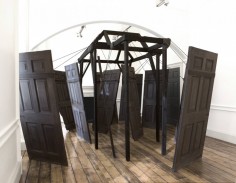Nika Neelova
Partings
source: highlike
Work: The subject of the work often revolves around the basic human requirement of the need to dwell, the need to inhabit, to connect, however temporarily to a place of belonging. This act is becoming more and more difficult with the ever shifting grounds of the present, attested by the many uninhibited and uninhabitable no-places in the cities.(1) Throughout my work I am interested in recreating these desolate environments, often possessing the quality of cinematic stills, depicting ‘lived-in’ and ‘lived-with’ fragments of architecture, slowly erasing the traces of their past and human connection. Crudely unweaving the architecture of the living space, the installations are often depicted in the state of arrested physical change, susceptible to forces of gravity, entropy and decay. Alluding to the meditation on the diverse themes of disillusionment and despair, imagery of death and self-denial, the work often addresses the collapse, the ‘architectural suicide’ of recognizable structures. (1) reference to text by Charles More, foreword to J. Tanizaki ‘In Praise of Shadows’ March 2012, by Alice E Vincent, Huffington Post Elsewhere in the East Wing, Nika Neelova’s Partings dominates a room. A huge installation, it is made of concrete casts of one of Somerset House’s six-panel Georgian doors. “They loaned it to me for a week,” the artist tells me. “For me, it was always important for the work to be site-specific. While Somerset House is palatial, it’s about contrast – here are doors taken out of their doorframes, it’s about dispossession and isolation.” Crisis is the first charity Neelova has worked with, an opportunity she calls an honour as well as an inspiration. “I really admire what they do – at the start of the project I went and met the clients, and see what they do. They help people back to life through art, it’s inspiring.” 2012, by Jacopo Nuvolari, 1883 Magazine Crisis, the national charity for single homeless people established in 1967, has organised a valuable show – The Crisis Commission – bringing together some of today’s most celebrated artist to confront the problem of homelessness. Curated by Laurence Sillars – chief curator at BALTIC Centre of Contemporary Art – and hosted by Somerset House, the exhibition includes Antony Gormley, Tracey Emin, Sir Anthony Caro, Yinka Shonibare, Gillian Wearing, Jonathan Yeo, Bob & Roberta Smith, Nathan Coley and Nika Neelova; their works are on display alongside those of artists who are themselves homeless or vulnerably housed. In the context of an exhibition which is undoubtedly far more than a charity event, particularly entrancing is Partings by Nika Neelova, a 25 year-old Russian born artist based in London.
Photographer: Sam Mellish
.
.
.
.
.
.
.
source: formidablemag
N. My work aims at creating present forms for selected narratives from the past and suggesting hypothetical futures for instants of the present. It often brings up fragments of architecture, attributed to various histories, decontextualising them and often rendering them redundant through their material transformation. I am interested in exploring the notion of the ruin, thereby addressing segments of existence that have or will collapse, distantly referencing the disillusionement and the disintegration of utopias that ensues from their confrontation with reality. Often reminiscent of the past, the pieces are also presupposing a future in which this present shifts into a state of disrepair.
.
.
.
.
.
.
.
source: saatchigallery
Nika Neelova makes sculptural installations out of reclaimed architectural features and burnt timber. Disassociated from their original use and re-composed in her new arrangements, these old beams, casts and worn ropes exude their own original energy as well as their heritage. They have become something other than what they were, while retaining a feeling of oneiric repetition – claiming a life of their own and a new purpose, but still clawing onto a past one.
Principles of Surrender is constructed out of six burnt wood posts which, with its slight cantilevers, support beams and mortise and tenon joints, resembles age-old vernacular architecture. Tied to the platform created by these posts are huge bell clappers which the artist has cast in wax infused with ash, creating an enormous congregation of bell pulls. But there is no bell to ring, because this structure is not a bell tower. Yet both of these images, and what they can connote, hover around as poetic associations within the same space. Similarly, Scaffolds Today, Monuments Tomorrow distressingly reads both like a seaside pier and a platform used to hang people.
Neelova’s works stand as odd, transparent altars to their elements’ origins, made up of elements that have survived despite being charred. They open up the distorted manner in which the past is read by the present, and what she refers to as “the historical memory that is embedded in materials.”
.
.
.
.
.
.
.
.
source: artlicks
The Royal British Society of Sculptors is delighted to present a new site specific installation by NIKA NEELOVA, winner of the HISTORIC section in this year’s Sculpture Shock awards, at Holy Trinity Church, Sloane Square. Extracting objects from their original context, Neelova re-casts each in different media. These items form thecomponent parts of her enigmatic and complex installations and retain what she refers to as ‘the historic memory which is embedded in materials’.
Sculpture Shock encourages surprising site-specific spatial interventions in non-traditional spaces, outside the confines of the white cube.


